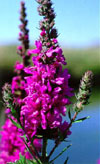Purple loosestrifeLythrum salicaria |
|||
| |
Click on thumbnails for larger view |
||
BackgroundIdentification
Identification key in: Hickman, J. ed. 1993. The Jepson Manual: Higher Plants of California. University of California Press. Growth and spread
Habitat and local distribution
Impacts
Prevention and ControlPrevention
General control notes
Manual or mechanical control(Monheit, pers. comm.)
Biological control
Chemical control
References and more information
Benefield, C. 2000. Lythrum salicaria. In Invasive Plants of California
Wildlands. Carla C. Bossard, John M. Randall, Marc C. Hoshovsky, Editors. University
of California Press. Available at
http://groups.ucanr.org/ceppc/Invasive_Plants_of_California's_Wildlands
.
Bossard, C., John M. Randall, Marc C. Hoshovsky, editors. 2000. Invasive Plants of California Wildlands. University of California Press. Available at http://groups.ucanr.org/ceppc/Invasive_Plants_of_California's_Wildlands . Gibbons, M.V., M.G. Rosenkranz, H.L. Gibbons, Jr., and M.D. Sytsma. 1999. Guide for Developing Integrated Aquatic Vegetation Management in Oregon. Center for Lakes and Reservoirs, Portland State University, Portland, OR. Grossinger, R., J. Alexander, A. Cohen, and J. Collins. 1998. Introduced Tidal Marsh Plants in the San Francisco Estuary: Regional Distribution and Priorities for Control. San Francisco Estuary Institute, Oakland California. Monheit, Susan. CDFA (California Department of Food and Agriculture). Personal communication. Element Stewardship Abstract for Lythrum salicaria, purple loosestrife. J. Bender and J. Rendall. 1987. The Nature Conservancy, Wildland Invasive Species Team. Arlington, VA. Available at http://tncweeds.ucdavis.edu/esadocs/documnts/lythsal.rtf . Techniques from TNC Stewards for the eradication of Lythrum salicaria (purple loosestrife) and Phragmites australis (common reed/Phrag) in wetlands. Mandy Tu (ed.). 2002. The Nature Conservancy, Wildland Invasive Species Team. University of California, Department of Vegetable Crops and Weed Sciences, Davis, CA. Available at http://tncweeds.ucdavis.edu/moredocs/lytsa01.rtf.
|
|||
| This page has been accessed | times. |



